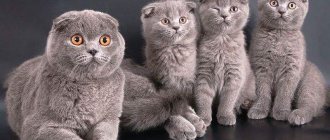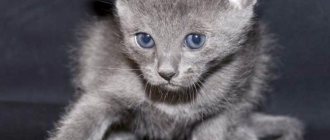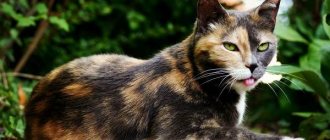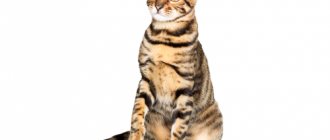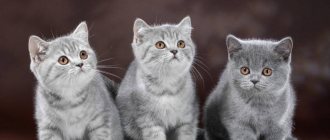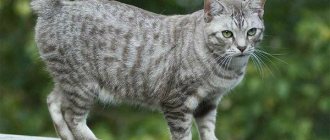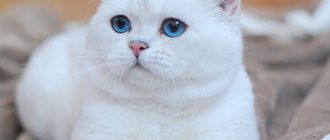Add a pet Add a video
Description of the breed
Dragon Li is a Chinese cat breed, very popular in its homeland, as well as in the United States. These cats were first presented in 2003 at one of the Beijing exhibitions, but the breed received official recognition only in 2010. Despite these figures, cats of the Li Hua breed are not at all new. They have been living in China for quite some time. It is believed that these are descendants of ancient cats that inhabited the mountains many centuries ago.
Dragon Lee is one of the ten most popular tabby cats in the United States, occupying an honorable third place. But in Russia this breed did not take root. Li Mao is too similar to our simple yard tabby cats.
Chinese or Gobi gray cat and description
August 16, 2022 Lyudmila page » Wild cats 264
Chinese cat, Chinese desert cat, Chinese mountain cat, Gobi gray cat - all these are the names of one cat.
It belongs to the subfamily of Small cats (Felinae), the genus of cats (Felis), the species of Chinese cats (Felis bieti - in honor of the French missionary and naturalist Felix Bie).
The Chinese themselves call this cat “huang mo mao”, which literally means: “a cat that lives in a desert area with sparse vegetation.” Since 1992, this cat was officially renamed the Chinese mountain cat, because... now it is found only in the mountains of China.
Appearance of a Chinese gray cat
This cat is slightly larger than the average domestic cat and is very similar in appearance to the European wild cat (Felis silvestris).
The cat's body is stocky. The body length of the Chinese cat is from 1 to 1.5 meters. A third of the length (from 29 to 35 cm) is on the tail. Height at withers is from 30 to 35 centimeters. Weight ranges from 4.5 to 9 kilograms. The legs are short relative to the body.
The head is wide with large ears with black tassels (up to 2.5 cm) at the ends. The muzzle is round with a small nose and green eyes.
The tail is thick with 4-6 dark transverse rings, like a raccoon. The tip of the tail is black.
The coat is long and dense with a good thick undercoat. By winter it becomes longer and thicker. The color of the fur coat is gray-yellow in summer and gray-brown in winter. The lower part of the body is lighter than the back.
Habitat and lifestyle of the Chinese cat
The Chinese cat lives mainly in steppe and mountainous regions in northwestern China and southern Mongolia and Tibet, in the most extreme climatic conditions, where in summer the temperature rises to 40 degrees, and in winter it drops below 30 degrees due to strong winds. They prefer alpine meadows and areas covered with bushes. In the mountains they have been seen at altitudes from 2,800 to 4,100 meters above sea level.
The Chinese cat is a nocturnal animal that leads a solitary lifestyle. She is very careful and it is almost impossible to meet her in the wild. Females and males live separately. They spend most of their time in burrows. Moreover, females’ burrows are much deeper and more protected than those of males.
One cat occupies an area of about 12-15 km2.
Scientists studied all its habits from individuals that were in the zoo.
What does a Chinese cat eat?
The Chinese cat feeds mainly on rodents and small mammals: mice, rats, zokor, moles, gophers, marmots and rabbits. Sometimes they do not disdain lizards, birds (pheasant, partridge) and insects.
Thanks to their sensitive hearing, these cats find tsokors and moles by the sound of their movements underground. And having discovered prey, the Chinese cat instantly tears up the ground and catches rodents.
How does a Chinese cat reproduce?
During the breeding season (January to March), Chinese cats live together. Pregnancy lasts 2-2.5 months. Shortly before the kittens are born, the cat develops a hole or den in tree trunks.
Usually 2-4 cubs are born. Kittens grow quickly and at 7-8 months are already completely independent from their mother. At 8-12 months they can reproduce on their own.
Chinese cat population
In the wild, Chinese cats live from 10 to 12 years. Like all wild relatives, this cat suffers most from human activity. Thanks to the thoughtless and careless extermination of rodents in 1958 with the help of pesticides, many wild animals were poisoned along with the rodents.
For 20 years, the Chinese poisoned rodents with zinc phosphide until they realized that in this way they also killed all the carnivores that hunted these same rodents.
Also, because of the fur from which the Chinese sew traditional hats, the population of Chinese cats is sharply declining. Now the number of this cat barely reaches 10 thousand individuals.
Conservation status of the Chinese cat
To date, the Chinese cat is listed in the Red Book and in Appendix II of CITES. This is the only cat that is entirely Chinese.
Chinese cats do not pose any danger to humans and livestock. On the contrary, by increasing their numbers it was possible to do without 20 years of poisoning rodents and everything around them with chemicals. So, one thoughtless cry caused irreparable damage to all living things.
History and breed standard
First of all, it is worth saying that the name “Dragon Li” is used only in Western countries and is used more for commercial purposes. Apparently to emphasize the ancient Chinese origin. In their homeland they are better known as Li Hua or Li Mao.
There is no exact information about the origin of these cats. It is only known that the Chinese consider Li Mao to be the descendants of Chinese mountain cats, which were subsequently domesticated.
Li Hua was first presented to the public in 2003. The preliminary standard for the breed was written in 2005, but the Li dragon received recognition only in 2010. At the same time, the first representatives of the breed were exported from China. Their popularity is quite high in China, as well as in the USA. In Europe, these cats are extremely rare, and in the CIS countries they are not known at all. Today, the Li dragon is considered one of the rarest cat breeds in the world.
Mr. Cat Recommends: Li Hua's Advantages and Disadvantages
Each breed has its pros and cons. This also applies to the Chinese cat. Here are some of its advantages:
- distinguished by devotion to its owner;
- has an exotic origin;
- has a light character, which allows him to live in harmony with other animals;
- there is no aggressiveness;
- does not require special attention;
- gets sick very rarely;
- characterized by intelligence and intelligence.
Negative parameters include the following:
- Difficulty in purchasing and selecting a partner for mating: a purebred breed can be found in China or the USA.
- High cost: a kitten is quite difficult to find.
- Normal development: requires a spacious room to allow for activity and movement.
- Attitude towards children: tolerant, but not for long, so it is better to avoid such contacts.
- Difference: Can be confused with other breeds.
External signs
At first glance, Dragon Li is no different from a mongrel domestic cat and an ignorant person cannot distinguish them. But of course, differences exist. Li Mao is a large, muscular cat with strong, strong legs and an even posture. Unlike most breeds, Li Hua's hind legs are the same length as her front legs. The tail is proportional to the length of the body and is quite thick.
The shape of the head is slightly elongated and has a graceful round forehead. The cat's face is round with an even profile and a massive chin. The eyes are the highlight of this breed. They have an almond shape and a slightly slanted fit. Eye color can be yellow or green.
Li Hua's coat is two-layered, thick and densely packed, but has practically no undercoat. Males' coats are usually rougher to the touch than cats'. The only color recognized as a standard is brown tabby. Black stripes should be on the head and throughout the body, the tail is covered with black rings, the tip is completely colored. Each individual hair of fur is colored in three shades: black, brown and light brown.
Cat health Dragon Lee
Since the breed arose naturally, the cats are in good health and do not have certain genetic diseases.
To maintain health, the animal should be promptly vaccinated against infectious and viral diseases. The first vaccinations are prescribed at the age of 3-4 months, repeated ones are given once a year. If a cat goes on a trip or changes its place of residence, a visit to the veterinarian and additional vaccinations are required.
Li Hua can live about 18 years with a balanced diet and proper care
Character
The Dragon Li is an affectionate and calm breed. Although these cats cannot be called independent, they are still less affectionate towards people than most breeds. Nevertheless, they easily make contact, are sociable and playful. Li Mao get along well with other animals in the house and do not show aggression. But cats of this breed do not get along well with children. They do not show aggression towards them, but they are not in a hurry to make friends, preferring to stay at a distance from them.
This breed is well suited for keeping in an apartment. Li Hua are moderately active, but quite calm. They do not refuse to play, but when they are at home on their own, they prefer to sleep peacefully in a secluded place.
Proper care and feeding
Chinese Li Huas love free space, so it is preferable to keep them in a private house or a spacious apartment, where they will have their own place.
If such an animal is given freedom, it will never go far from home, since it prefers warm rooms rather than cold streets. Caring for this breed is extremely easy. You only need to comb the coat a couple of times a week, and during the shedding period it is better to do this daily. You should bathe no more than 2 times a year. Since Li Hua are sensitive to drafts, they must be dried with a hairdryer after water treatments. And also in cold seasons, it is best to dress these cats in special clothes so that they do not catch a cold.
Every month it is necessary to trim the nails, but this is only if the pet is completely indoors and does not go outside. You should only cut off a couple of millimeters so as not to touch the blood vessel. Periodically, you need to wash your ears and eyes with a cloth soaked in warm water.
Due to the fact that such cats had wild ancestors, they love to sharpen their claws, so it is imperative to purchase a scratching post for them. It is best that it be vertical and have a rope made of natural fibers. To train your pet to use a scratching post rather than wallpaper or furniture, you can drop a couple of drops of valerian on it. It is advisable to purchase a tray with high sides and keep it clean.
Breeders prefer to feed such cats with premium ready-made dry or wet food. But if you wish, you can accustom your pet to natural products. In this case, it is necessary to add vitamins to the diet. Chinese cats have an excellent appetite and their diet should be balanced and enriched with proteins. This breed has no tendency to be overweight.
It is advisable to feed Li Hua at the same time. Adults need to be given food twice a day. It shouldn't be cold or hot. If the diet is mixed, then natural food must be served separately from prepared food. For example, feed dry food in the morning and natural food in the evening.
You can feed:
- lean meat;
- vegetables;
- porridge;
- offal;
- boiled sea fish;
- low-fat and natural dairy products (infrequently);
- soft bones and cartilage (not fish or chicken).
Meat, vegetables and cereals must be boiled before serving. Sweets, pork, sausages, fatty dairy products, salty foods and fruits should be excluded from the diet. The animal should have two bowls - for food and water. Cats should always have access to quality drinking water.
Li Hua have relatively good health and immunity. In addition, this breed does not have pronounced genetic diseases. They are very sensitive to drafts due to the lack of undercoat, so they should always be kept warm. Once every six months, Chinese cats require examination by a veterinarian, as well as regular vaccinations. Be sure to protect your pet's fur from insects and parasites. If all recommendations for care and feeding are followed, such pets can live 14-15 years.
Unfortunately, this breed has not become widespread and today there are very few of their representatives. It is quite difficult to purchase such an animal outside of China, since only there are several breeders breeding this breed. Therefore, the prices for Li Hua kittens are quite high.
Education and training
The Chinese claim that a smarter and more pliable breed cannot be found. Li Hua are smart and grasp everything literally on the fly. A cat can easily be taught various commands. The main thing here is to find the right approach. These cats are very loyal to their owners and try to please them in everything. Perhaps this is precisely the secret of such pliability to training.
There is no need to raise a cat of this breed at all. The mother cat herself accustoms her children to the tray and to the designated place for eating.
Features of mating Chinese Li Hua cats
Chinese cats develop more slowly than other representatives of the cat world. They reach sexual maturity only after three years. It is strictly not recommended to breed them earlier, since early pregnancy can result in a miscarriage or even the death of the cat. Males are ready to mate after about two years of age. As a rule, a sexually mature female Li Hua does not have problems during the gestation period. Childbirth is easy and natural. Representatives of this slowly maturing breed can give birth no more than once a year.
It is difficult to find a partner for a Chinese cat
Breeding Chinese cats is extremely difficult, not only because of their small numbers, but also because of the low popularity of this breed. Visually, only a specialist can distinguish a purebred Li Hua from a simple yard dog. It will not be possible to find a partner for a pet in Russia; to do this you will have to visit China or the USA. When choosing a pair, consider the following:
- appearance of a potential partner: compliance with breed characteristics;
- health and activity.
purebred, there must be appropriate documents (club book, veterinary card, pedigree, etc.); availability of timely vaccination and regular prevention of parasite infection.
Pedigree cats must have pedigrees
Cat lovers I know say that when a breeder has few breeding animals, he often resorts to inbreeding. This fact negatively affects the health of the offspring, since the chances of developing genetic diseases or physical defects increase significantly. You should carefully study the pedigree up to the fourth generation.
Maintenance, care, health
Li Mao reaches puberty later than other cats. An adult is considered an individual who has reached the age of three. This also determines that the kitten is not separated from its mother earlier than twelve weeks.
Dragon Li does not require extensive care. He has short hair that has virtually no undercoat. You need to comb your fur coat no more than once a week. For these purposes, a rubber massage mitten is quite suitable, which will not only remove dead hairs and improve blood circulation, but will also bring unearthly pleasure to the cat.
Bathing is recommended as needed, but not more than once a month. For bathing products, you can use both cat and regular baby shampoos.
Li Mao's cats are of aboriginal origin. They have not been crossed with other breeds, which means they do not have genetic diseases associated with this. They have good health and, with proper care, can easily live up to 18–20 years.
How much does it cost and how to choose a kitten
It is quite difficult to buy a representative of this species, because... nurseries are located mainly in China. You not only need to purchase a kitten, but also pay for its transportation. Their cost is high - from $500 and above. If they offer to buy a cat at a low price, then it cannot be a representative of this rare breed.
When choosing, be sure to pay attention to the presence of:
- breed standards;
- pedigree;
- list of vaccinations given;
- healthy appearance;
- natural activity.
The kitten should not have any physical disabilities and be 3-4 months old or older.
1111
